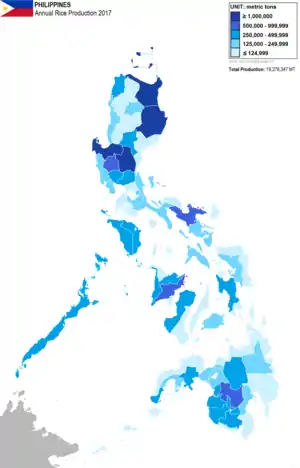Rice production in the Philippines
Rice production in the Philippines is an important aspect of the country's food supply and economy. The Philippines is the 8th largest rice producer in the world, accounting for 2.8% of global rice production.[1] The Philippines was also the world's largest rice importer in 2010.[2]


Rice production
Geography of production
Rice is the most important food crop, a staple food in most of the country. It is produced extensively in Luzon, the Western Visayas, Southern Mindanao, and Central Mindanao. [3]
Total production
In 2010, nearly 20.7 million metric tons of palay (pre-husked rice) were produced.[4] In 2010, palay accounted for 21.86% percent of gross value added in agriculture and 2.37% of GNP. [5]
In 2017, the total paddy rice output met 93% of the country's annual requirement. The population consumed 11.7 million tonnes of rice.[6]
History

Historically, the per hectare rice yields in the Philippines have generally been low in comparison with other Asian countries.[3]
The Green Revolution
Since the mid-1980s yields have increased substantially as a result of the cultivation of high-yielding rice varieties developed in the mid-1960s at the International Rice Research Institute located in the Philippines. The proportion of "miracle" rice in total output rose from zero in 1965-66 to 81 percent in 1981-82.[3] Average productivity increased from 1.23 metric tons per hectare in 1961 to 3.59 metric tons per hectare in 2009. [1]
This green revolution was accompanied by an expanded use of chemical inputs. Among farmers surveyed in Central Luzon, the quantity of insecticide active ingredient applied per hectare increased tenfold from 1966 to 1979, from less than 0.1 kilogram per hectare to nearly 1.0 kilogram per hectare. By the mid-1990s, this figure had been cut in half. Since then, use has declined even more, and levels of insecticide use are now slightly below what they were before the Green Revolution began.
Growth of irrigation
The government also undertook a major expansion of the nation's irrigation system. The area under irrigation grew from under 500,000 hectares in the mid-1960s to 1.5 million hectares in 2009, almost half of the potentially irrigable land.[4]
In the 1980s rice production encountered problems. Average annual growth for 1980-85 declined to a mere 0.9 percent, as contrasted with 4.6 percent for the preceding fifteen years. Growth of value added in the rice industry also fell in the 1980s. Tropical storms and droughts, the general economic downturn of the 1980s, and the 1983-85 economic crisis all contributed to this decline.[3]
Crop loans dried up, prices of agricultural inputs increased, and palay prices declined. Fertilizer and plant nutrient consumption dropped 15 percent. Farmers were squeezed by rising debts and declining income. Hectarage devoted to rice production, level during the latter half of the 1970s, fell an average of 2.4 percent per annum during the first half of the 1980s, with the decline primarily in marginal, nonirrigated farms. As a result, in 1985, the last full year of the Marcos regime, the country imported 538,000 tons of rice.[3]
The situation improved somewhat in the late 1980s, and smaller amounts of rice were imported. In 1990 the country experienced a severe drought. Output fell by 1.5 percent, forcing the importation of an estimated 400,000 tons of rice.[3]
As of 2018, the Philippines had a WTO-approved annual quota limiting private rice imports to protect local farmers, buying up to 805,200 tonnes of rice with a 35 percent import tariff.[6]
See also
References
| Wikimedia Commons has media related to Paddy fields in the Philippines. |
![]() This article incorporates public domain material from the Library of Congress Country Studies website http://lcweb2.loc.gov/frd/cs/.
This article incorporates public domain material from the Library of Congress Country Studies website http://lcweb2.loc.gov/frd/cs/.
- "2009 Crop Production Statistics". FAO Stat. FAO Statistics. Retrieved 30 March 2011.
- "Factbox - Top 10 rice exporting, importing countries". Reuters. 28 January 2011. Retrieved 30 March 2011.
- "Philippines: A Country Study:Rice and the Green Revolution". Library of Congress, Washington, D.C. June 1991. Retrieved March 21, 2009.
- "Palay: Volume of Production by Cereal Type, Geolocation, Period and Year". CountrySTAT Database. Bureau of Agricultural Statistics. Archived from the original on 20 March 2011. Retrieved 30 March 2011.
- "Philippine economy posts 7.1 percent GDP growth". National Accounts of the Philippines. National Statistical Coordination Board. Archived from the original on 15 April 2011. Retrieved 30 March 2011.
- "Philippines to Import Rice Through 2020 Despite Rising Output - Minister". Reuters (via Agriculture.com). 19 June 2018. Retrieved 4 July 2018.